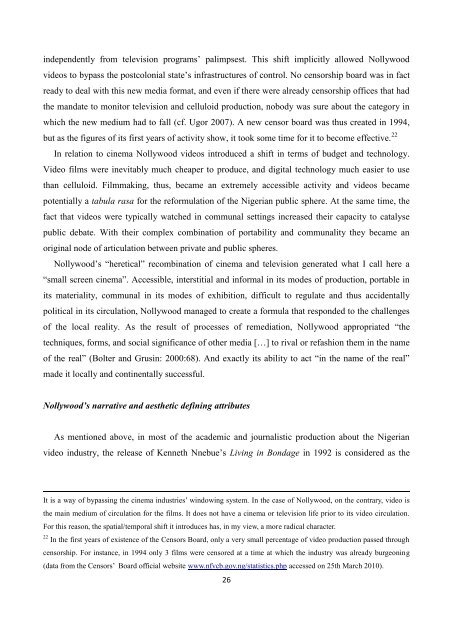Create successful ePaper yourself
Turn your PDF publications into a flip-book with our unique Google optimized e-Paper software.
independently from television programs’ palimpsest. This shift implicitly allowed Nollywoodvideos to bypass the postcolonial state’s infrastructures of control. No censorship board was in factready to deal with this new media format, and even if there were already censorship offices that hadthe mandate to monitor television and celluloid production, nobody was sure about the category inwhich the new medium had to fall (cf. Ugor 2007). A new censor board was thus created in 1994,but as the figures of its first years of activity show, it took some time for it to become effective. 22In relation to cinema Nollywood videos introduced a shift in terms of budget and technology.Video films were inevitably much cheaper to produce, and digital technology much easier to usethan celluloid. Filmmaking, thus, became an extremely accessible activity and videos becamepotentially a tabula rasa for the reformulation of the Nigerian public sphere. At the same time, thefact that videos were typically watched in communal settings increased their capacity to catalysepublic debate. With their complex combination of portability and communality they became anoriginal node of articulation between private and public spheres.Nollywood’s “heretical” recombination of cinema and television generated what I call here a“small screen cinema”. Accessible, interstitial and informal in its modes of production, portable inits materiality, communal in its modes of exhibition, difficult to regulate and thus accidentallypolitical in its circulation, Nollywood managed to create a formula that responded to the challengesof the local reality. As the result of processes of remediation, Nollywood appropriated “thetechniques, forms, and social significance of other media […] to rival or refashion them in the nameof the real” (Bolter and Grusin: 2000:68). And exactly its ability to act “in the name of the real”made it locally and continentally successful.Nollywood’s narrative and aesthetic defining attributesAs mentioned above, in most of the academic and journalistic production about the Nigerianvideo industry, the release of Kenneth Nnebue’s Living in Bondage in 1992 is considered as theIt is a way of bypassing the cinema industries’ windowing system. In the case of Nollywood, on the contrary, video isthe main medium of circulation for the films. It does not have a cinema or television life prior to its video circulation.For this reason, the spatial/temporal shift it introduces has, in my view, a more radical character.22 In the first years of existence of the Censors Board, only a very small percentage of video production passed throughcensorship. For instance, in 1994 only 3 films were censored at a time at which the industry was already burgeoning(data from the Censors’ Board official website www.nfvcb.gov.ng/statistics.php accessed on 25th March 2010).26
















